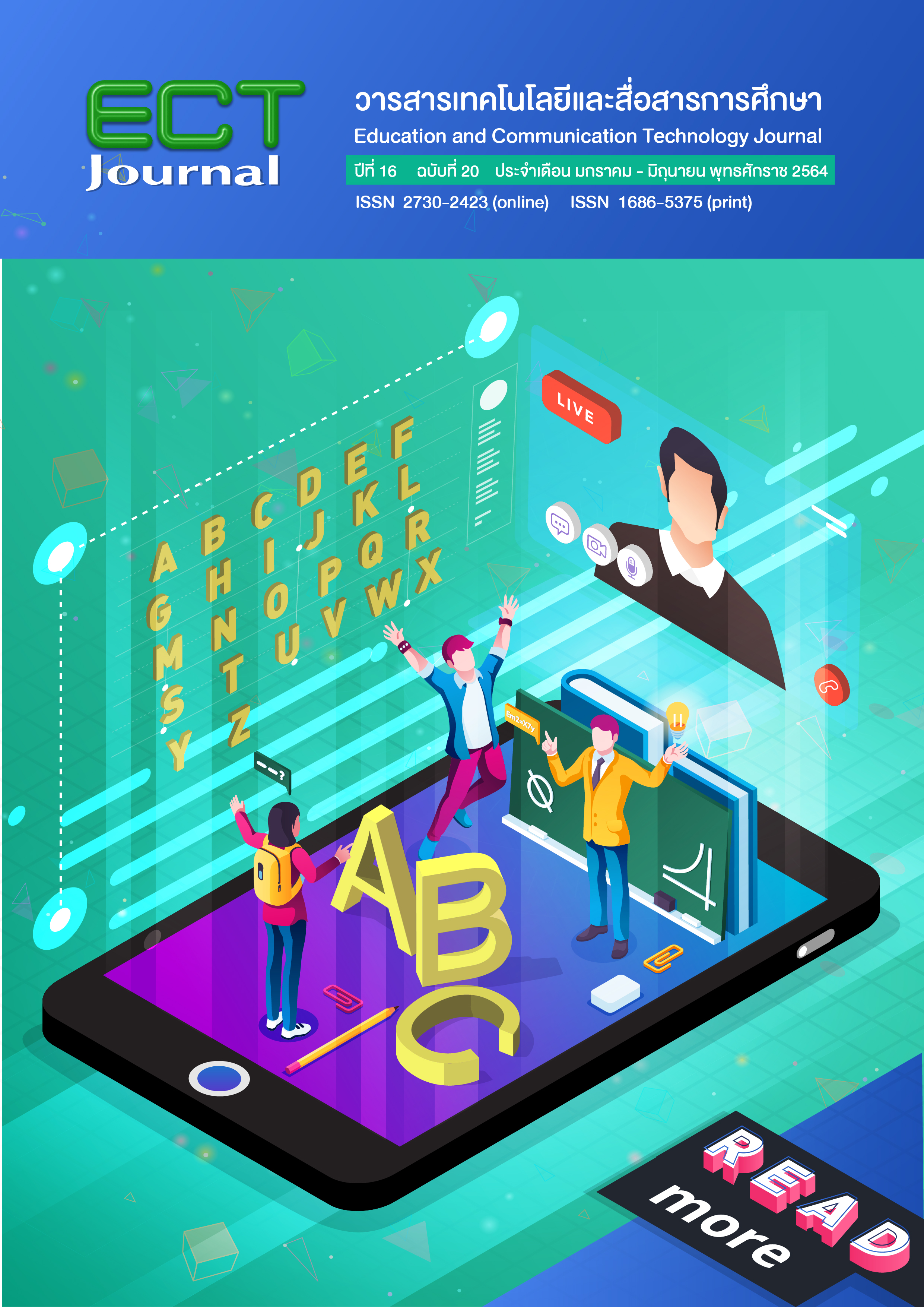The Report on Using Web Application Based on Mobile Learning Instructional Model Using Brain-Based Learning and Phonics Method to Enhance English Vocabulary Pronunciation Skill
Keywords:
Mobile Learning, Web application, Brain-based Learning, Phonics Method, English Vocabulary PronunciationAbstract
The objectives of this research were to 1) develop web application based on mobile learning instructional model using brain-based learning and phonics method (BBLP Model), and 2) study the report on using web applications based on mobile learning instructional model using brain-based learning and phonics method. The sample was 30 English major students at the Faculty of Humanities, Kasetsart University, who enrolled in 01355382 English Sound Systems during the first semester of 2019. They were selected using multistage sampling method. The research instruments used were (1) a quality evaluation form for the web application and user manual to be filled by experts (2) the web application based on BBLP Model (3) an English final consonant pronunciation test (4) a pronunciation test score sheet to be graded by experts and (5) an interview form for opinions of learners. The data collected were analyzed using mean, standard deviation, percentage, dependent t-test, relative gain score, and qualitative data analysis.
The results were found that.
1) Based on expert evaluation, the web application exceled in the area of media design (M =4.57, S.D. = 0.54) and content (M =4.82, S.D. = 0.39). The efficiency of web application based on BBLP model was 69.08% which corresponding with criteria.
2) As a result of using the web application, learners’ English pronunciation score improved at the significant level of 0.05. Most students’ relative gain score was moderate (between 25.00 - 47.06%) and all students agreed that the web application was appropriate and helped them improve their English pronunciation.
References
จีรพรรณ พรมประเสริฐ. (2557). รายงานการวิจัย เรื่อง การวิเคราะห์ปัญหาและสาเหตุที่ทำให้เกิดการออกเสียงภาษาอังกฤษที่ผิดพลาดของนักศึกษาสาขาวิชาภาษาอังกฤษ. สาขาวิชาภาษาอังกฤษธุรกิจบริการ คณะมนุษยศาสตร์และสังคมศาสตร์ มหาวิทยาลัยราชภัฏเพชรบูรณ์. https://research.pcru.ac.th/rdb/project/261
ใจทิพย์ ณ สงขลา. (2561). การออกแบบการเรียนแนวดิจิทัล. สำนักพิมพ์แห่งจุฬาลงกรณ์มหาวิทยาลัย
ชรินทร์ธรณ์ คัญทัพ และศิริพงษ์ เพียศิริ. (2555). การพัฒนาทักษะการอ่านภาษาอังกฤษของนักเรียนชั้นประถมศึกษาปีที่ 4 โดยใช้แนวคิดการเรียนรู้แบบใช้สมองเป็นฐาน. วารสารศึกษาศาสตร์มหาวิทยาลัยขอนแก่น, 35(3), 9-14. https://so04.tci-thaijo.org/index.php/EDKKUJ/article/view/241922
ณัฐนันท์ นิเวศน์วรการ. (2561). การใช้การสอนแบบโฟนิกส์เพื่อส่งเสริมความสามารถในการออกเสียงความรู้คำศัพท์และการอ่านภาษาอังกฤษของนักเรียนชั้นมัธยมศึกษาปีที่ 2. วารสารวิจัยทางการศึกษา คณะศึกษาศาสตร์ มศว, 13(1), 69-80. https://so01.tci-thaijo.org/index.php/OJED/article/view/170647
ถิรวัฒน์ ตันทนิส. (2555). การศึกษาปัญหาการออกเสียงภาษาอังกฤษและกลวิธีการเรียนการออกเสียงภาษาอังกฤษของนักศึกษาสหวิทยาการชั้นปีที่ 3 มหาวิทยาลัยธรรมศาสตร์. วารสารภาษาและภาษาศาสตร์, 31(1), 87-110. https://so04.tci-thaijo.org/index.php/JLA/article/view/53254
นิพนธ์ บริเวธานันท์. (2561). การพัฒนารูปแบบเว็บแอปพลิเคชันด้วยการเรียนรู้แบบร่วมมือผ่านห้องเรียนไร้กรอบเพื่อส่งเสริมการรู้เทคโนโลยีสารสนเทศและการสื่อสารสำหรับผู้เรียนระดับอุดมศึกษา [ปริญญานิพนธ์ดุษฎีบัณฑิต, มหาวิทยาลัยเกษตรศาสตร์]. ฐานข้อมูลงานวิจัย มหาวิทยาลัยเกษตรศาสตร์. https://research.ku.ac.th/forest/Search.aspx?keyword=นิพนธ์+บริเวธานันท์
วิระพงศ์ จันทร์สนาม. (2561). การเขียนโปรแกรมเว็บเบื้องต้นด้วย PHP & MySQL. โรงพิมพ์มหาวิทยาลัยขอนแก่น.
ศิตา เยี่ยมขันติถาวร. (2556). ความรู้เบื้องต้นที่ครูสอนภาษาอังกฤษควรรู้เกี่ยวกับการออกเสียง (พิมพ์ครั้งที่ 2). สำนักพิมพ์แห่งจุฬาลงกรณ์มหาวิทยาลัย.
สุมาลี ชัยเจริญ. (2551). เทคโนโลยีการศึกษา: หลักการ ทฤษฎี สู่การปฏิบัติ. คลังนานาวิทยา.
สืบวงศ์ ชื่นสมบัติ. (2563). การพัฒนารูปแบบการเรียนการสอนผ่านโมบายเลิร์นนิงตามหลักการเรียนรู้โดยใช้สมองเป็นฐานร่วมกับวิธีการสอนแบบโฟนิกส์ เพื่อเสริมสร้างทักษะการออกเสียงคำศัพท์ภาษาอังกฤษ สำหรับนักศึกษาระดับปริญญาตรี [ปริญญานิพนธ์ดุษฎีบัณฑิต, มหาวิทยาลัยเกษตรศาสตร์]. ฐานข้อมูลงานวิจัย มหาวิทยาลัยเกษตรศาสตร์. https://research.ku.ac.th/forest/Search.aspx?keyword=สืบวงศ์+ชื่นสมบัติ
Adjei, E. (2016). The effect of using the phonics method of teaching reading and comprehension on junior high school students: A case study of Axim Road M.A. Zion Junior High School [Master's thesis, University of Cape Coast]. Institutional Repository of University of Cape Coast. https://ir.ucc.edu.gh/xmlui/handle/123456789/2948
Chunsuvimol, B., & Ronakiat, N. (2000). Stylistic variation of [f] and [v] in the English of Thai students. Thammasat Review, 6(1), 177-195. https://tci-thailand.org/wp-content/themes/magazine-style/tci_search/author.html?b3RPcg==&b3BQZXJ5ZWFy&ZmllbGQ9&sort=&limit=10&limitstart=0
Gikas, J., & Grant, M. M. (2013). Mobile computing devices in higher education: Student perspectives on learning with cellphones, smartphones & social media. Internet and Higher Education, 19, 18-26. https://doi.org/10.1016/j.iheduc.2013.06.002
Lina, Y. T., & Joua, M. (2012). A web application supported learning environment for enhancing classroom teaching and learning experiences. Procedia - Social and Behavioral Sciences, 64, 1-11. https://doi.org/10.1016/j.sbspro.2012.11.001
Muhammed, A. (2014). The impact of mobiles on language learning on the part of English foreign language (EFL) university students. Procedia - Social and Behavioral Sciences, 136, 104-108. https://doi.org/10.1016/j.sbspro.2014.05.297
Thongsin, N. (2007). A study of English pronunciation problems for Thai learners [Master's thesis, Naresuan University]. http://www.teacher.nu.ac.th/waraporn_k/downloadfiles/pronunciation.pdf
Wei, Y., & Zhou, Y. (2002). Insights into English pronunciation problems of Thai students. ERIC Document Reproduction Service. https://eric.ed.gov/?id=ED476746
Yagcioglu, O. (2014). The advantages of brain based learning in ELT classes. Procedia - Social and Behavioral Sciences, 152, 258-262. https://doi.org/10.1016/j.sbspro.2014.09.186
Downloads
Published
How to Cite
Issue
Section
License
Copyright (c) 2021 มหาวิทยาลัยสุโขทัยธรรมาธิราช

This work is licensed under a Creative Commons Attribution-NonCommercial-NoDerivatives 4.0 International License.
1. ทรรศนะและข้อคิดเห็นใด ๆ ที่ปรากฏอยู่ในวารสาร ECT Education and Communication Technology Journal เป็นของผู้เขียนโดยเฉพาะ สำนักเทคโนโลยีการศึกษา มหาวิทยาลัยสุโขทัยธรรมาธิราช และกองบรรณาธิการไม่จำเป็นต้องเห็นพ้องด้วย
2. กองบรรณาธิการของสงวนลิขสิทธิ์ในการบรรณาธิการข้อเขียนทุกชิ้น เพื่อความเหมาะสมในการจัดพิมพ์เผยแพร่






